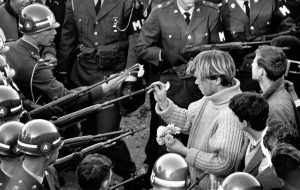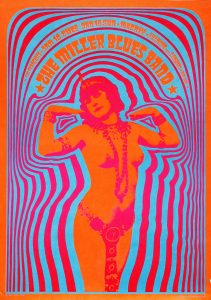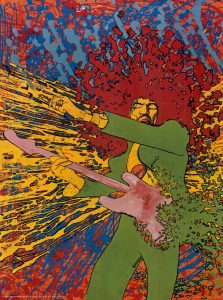The counterculture movement of the 20th century was kick started in the 1960s and marked the last half of the previous century as a time of activism, social movements and arts. In order for something to be counter to something, the other needs to exists, and in this case, it is a mainstream culture of the US and Western and Northern Europe of that time.
Bernie Boston, an American photographer took a black and white shot of a Vietnam War protestor, also in front of the Pentagon. Named “Flower Power,” a young man gently inserts the stem of a flower into the barrel of a gun. This era was in opposition to war and a protest against the Vietnam war. Many graphics and pieces of art were designed with an emphasis on ‘get out america’ and ‘peace and love’
This was a time of sex, drugs and rock n roll. The contraceptive pill, women liberation and the mini skirt were all on the rise and all this was being demonstrated within the art and graphics being created underground.
Neon Rose #2 ‘My first psychedelic pin up and the first to carry the ‘Neon Rose’ name. One of my more popular posters back then and now. It was printed 3 times.”
The psychedelic art style influenced by hallucinatory drugs, such as LSD, with design motifs including abstract swirls of intense colour usually opposite ends of the wheel chart with curvy typography with an Art Nouveau influence. This style has had an effect on, not just on art, but also on many aspects of pop culture. This included style of dress, language, art and literature. This style of design has had a lasting impact on contemporary practitioners. Above is a poster created by an American graphic designer, Dan Stiles, for a Arctic Monkeys concert at Artpark Outdoor Ampitheater on June 18, 2014. This has a clear reflection of 60’s psychedelia.
‘Felix’s poster collection was very personal; he collected what he liked, rather than obsessively ticking things off a list. As a consequence he concentrated on artists he really admired such as Martin Sharp, the first graphic designer of Oz as well as a good friend and the principal artist for Big O posters. His Exploding Hendrix, based on a photograph by Linda Eastman – soon to be McCartney – is among the most evocative and iconic images of the 1960s’
Boston, B. (1967). Flower Power. [Photograph].
Moscoso, V. (1967). Neon Rose no.2.
Sharp, M. (1968). Exploding Hendrix.
Stiles, D. (2014). Arctic Monkeys. [Screen print].
the Guardian. (2017). Kiss the sky: psychedelic posters of the 60s and 70s – in pictures. [online] Available at: https://www.theguardian.com/artanddesign/gallery/2016/oct/06/psychedelic-posters-1960s-cultural-traffic-felix-dennis [Accessed 21 Nov. 2017].
Widewalls. (2017). Counterculture in Society and Art. [online] Available at: https://www.widewalls.ch/counterculture/ [Accessed 21 Nov. 2017].




